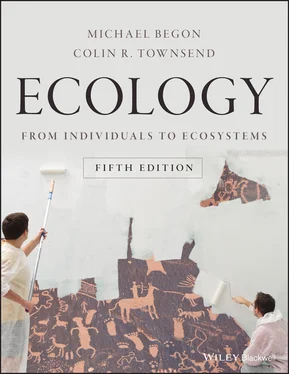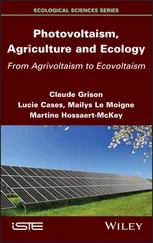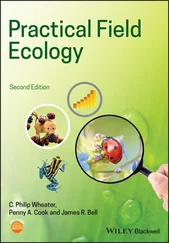1.2 Specialisation within species
The natural world is not composed of a continuum of types of organism each grading into the next: we recognise boundaries between one type of organism and another. Nevertheless, within what we recognise as species (defined below), there is often considerable variation, and some of this is heritable. It is on such intraspecific variation, after all, that plant and animal breeders – and natural selection – work.
The word ‘ ecotype ’ was first coined for plant populations (Turesson, 1922a, 1922b) to describe genetically determined differences between populations within a species that reflect local matches between the organisms and their environments. But evolution forces the characteristics of populations to diverge from each other only if: (i) there is sufficient heritable variation on which selection can act; and (ii) the forces favouring divergence are strong enough to counteract the mixing and hybridisation of individuals from different sites. Two populations will not diverge completely if their members (or, in the case of plants, their pollen) are continually migrating between them and mixing their genes.
Local, specialised populations become differentiated most conspicuously amongst organisms that are immobile for most of their lives. Motile organisms have a large measure of control over the environment in which they live; they can recoil or retreat from a lethal or unfavourable environment and actively seek another. Sessile, immobile organisms have no such freedom. They must live, or die, in the conditions where they settle. Populations of sessile organisms are therefore exposed to forces of natural selection in a peculiarly intense form.
This contrast is highlighted on the seashore, where the intertidal environment continually oscillates between the terrestrial and the aquatic. The fixed algae, sponges, mussels and barnacles all tolerate life somewhere along the continuum. But the mobile shrimps, crabs and fish track their aquatic habitat as it moves; whilst the shore‐feeding birds track their terrestrial habitat. The mobility of such organisms enables them to match their environments to themselves. The immobile organism must match itself to its environment.
1.2.1 Geographic variation within species: ecotypes
geographic variation on a small scale
Differentiation within a species can occur over a remarkably small geographic scale. In the case of sweet vernal grass, Anthoxanthum odoratum , growing along a 90 m transition zone between mine and pasture soils at the Trelogan zinc and lead mine in Wales, there was a striking increase in evolved tolerance to zinc, at otherwise toxic concentrations, over a distance of only 3 m within the zone. In this case, any counteracting mixing and hybridisation of the ecotypes was reduced because plants growing on the mine soil tended to flower later than their counterparts in the pasture (Antonovics, 2006).
…. and a large scale
In a study with a much broader geographic range, common frogs ( Rana temporaria ) were monitored over a latitudinal gradient encompassing Sweden and Finland. Geographic variation within species is generally studied both in situ and using a ‘common garden’ approach, where individuals from different sites are transplanted and grown together, thus eliminating any influence of immediate environments. In this case, while there was considerable variation in tadpole development time (from complete gill absorption to emergence of the first foreleg), no consistent trend with latitude was evident ( Figure 1.2a). However, when tadpoles from different sites were reared in a common environment, at a range of temperatures, those from higher latitudes developed significantly faster. There had clearly been local adaptation, and frogs experiencing colder temperatures (at higher latitudes) had evolved compensatory increases in development rate. The net result was that development times were similar at different latitudes.
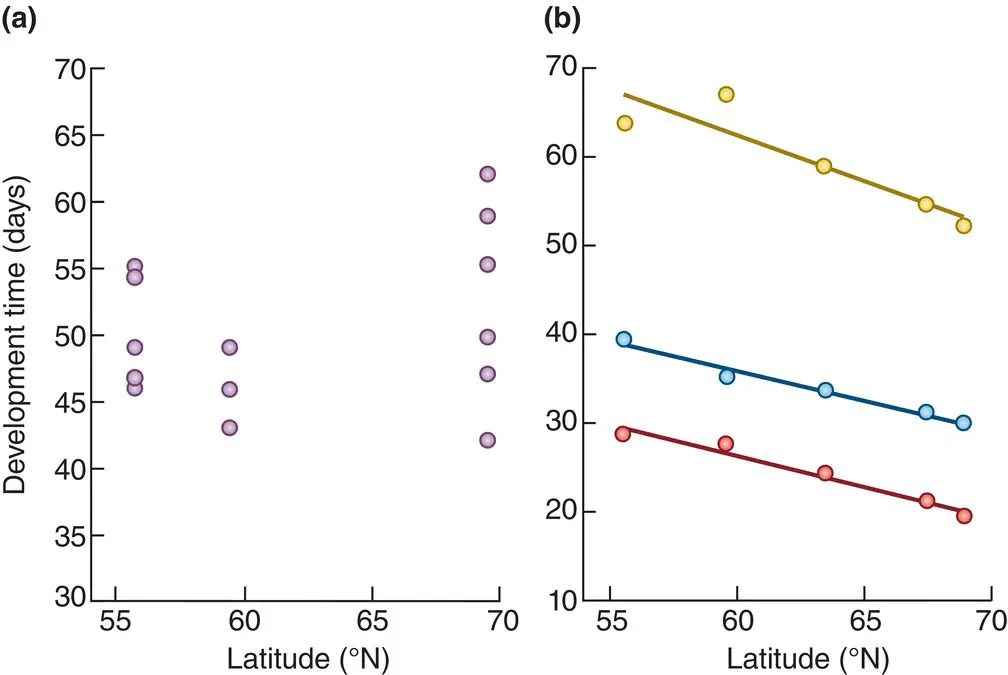
Figure 1.2 At a given temperature, tadpoles from higher latitudes developed faster than those from lower latitudes.(a) Tadpoles from ponds in two areas of Sweden, in the south, and from Finland, in the north, showed variation in development times but no consistent trend with latitude. (b) When tadpoles from sites at various latitudes were reared in the laboratory at different temperatures, those from higher latitudes consistently developed fastest. Temperatures: 14°C (yellow circles), 18°C (blue circles), and 22°C (red circles).
Source : From Laugen et al . (2003).
APPLICATION 1.1 Selection of ecotypes for conservation
The sapphire rockcress, Arabis fecunda , is a rare perennial herb restricted to calcareous soil outcrops in western Montana (USA) – so rare, in fact, that there are just 19 existing populations separated into two groups (‘high elevation’ and ‘low elevation’) by a distance of around 100 km. Whether there is local adaptation is of practical importance for conservation: four of the low‐elevation populations are under threat from spreading urban areas and may require reintroduction from elsewhere if they are to be sustained. Reintroduction may fail if local adaptation is too marked. Observing plants in their own habitats and checking for differences between them would not tell us if there was local adaptation in the evolutionary sense. Differences may simply be the result of immediate responses to contrasting environments made by plants that are essentially the same. But once again, the ‘common garden’ approach circumvents this problem. The low‐elevation sites were more prone to drought – both the air and the soil were warmer and drier – and the low‐elevation plants in the common garden were indeed significantly more drought tolerant ( Figure 1.3). More generally, we need to improve our understanding of local adaptation, and its genetic basis, because of their importance for the conservation and restoration of genetic resources, and for crop and animal production, and this is of particular significance in a changing climate (McKay et al ., 2005; Savolainen et al ., 2013).
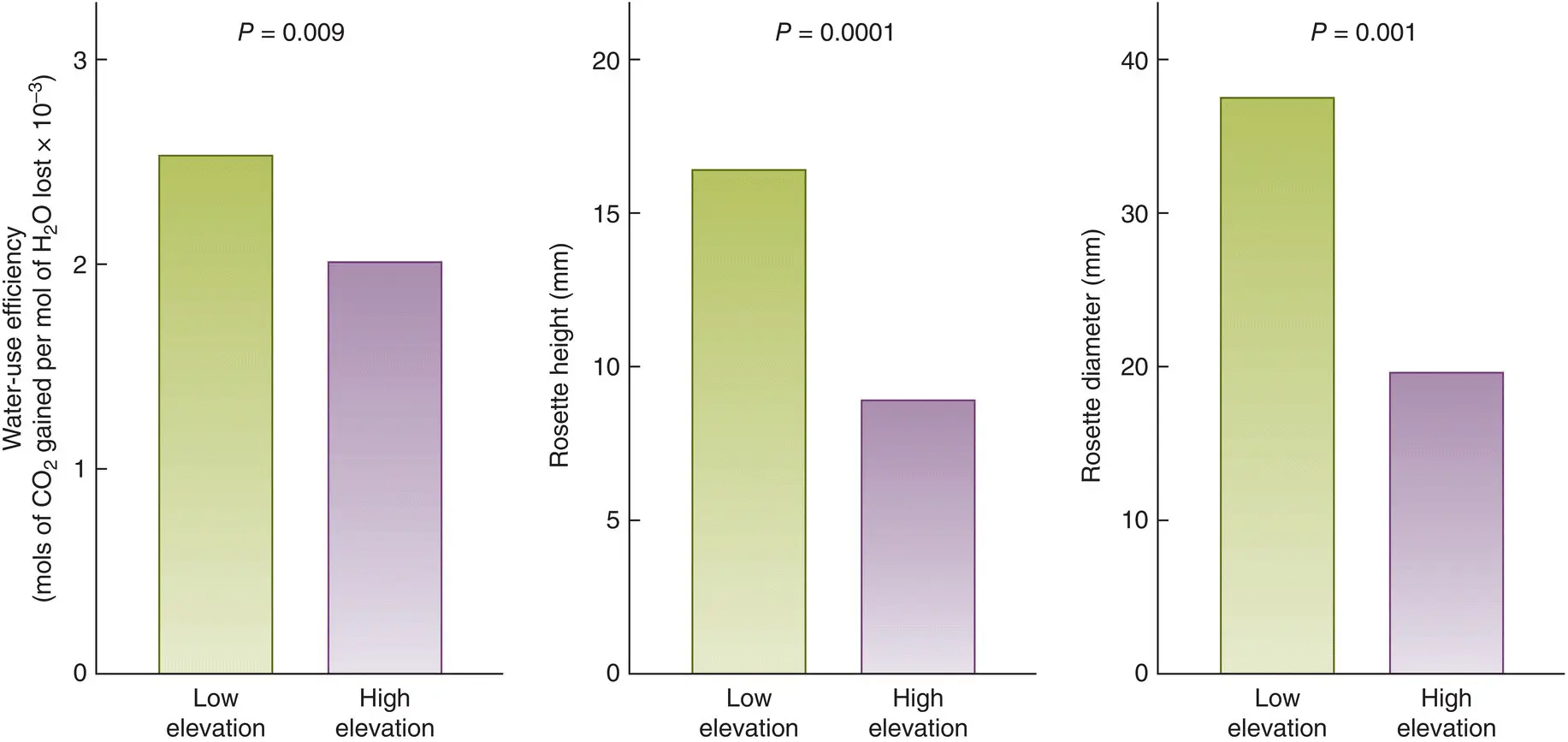
Figure 1.3 Local adaptation of rare sapphire rockcress plants.When plants of the rare sapphire rockcress from low‐elevation (drought‐prone) and high‐elevation sites were grown together in a common garden, there was local adaptation: those from the low‐elevation site had significantly better water‐use efficiency as well as having both taller and broader rosettes.
Source : From McKay et al . (2001).
the balance between local adaptation and hybridisation
On the other hand, local selection by no means always overrides hybridisation. In a study of Chamaecrista fasciculata , an annual legume from disturbed habitats in eastern North America, plants were grown in a common garden that had been derived from the ‘home’ site or were transplanted from distances of 0.1, 1, 10, 100, 1000 and 2000 km (Galloway & Fenster, 2000). The study was replicated three times: in Kansas, Maryland and northern Illinois. Five characteristics were measured: germination, survival, vegetative biomass, fruit production and the number of fruit produced per seed planted. But for all characters in all replicates there was little or no evidence for local adaptation except for transplant distances of 1000 km or more. There is ‘local adaptation’ – but in this case it was clearly not that local.
Читать дальше
